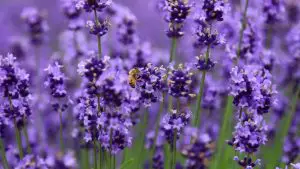The flavor of honey depends on the type of flowers within roughly 2 miles of the hive that produces it.
This is because Honey Bees have an average foraging radius of two miles, and the type of flower the bees gather nectar from directly influences both the flavor and color of the honey they produce.
Does all honey taste the same?
When you say the word ‘Honey’ far too often people imagine the tiny plastic bottles that are mass produced, and stocked on grocery store shelves across the nation. Store-bought bottles of ‘honey’ are mostly homogenized substances that are specifically designed to taste exactly the same. This leads to a consistent product that customers can rely on. Unfortunately it also removes any of the nuances and complexities that more natural honey can offer.

The complex flavor profiles of honey straight from the hive can be influenced by a variety of factors. These factors are primarily determined by location, and season. In many ways, honey is not much different from a fine wine, in that the complexity of the flavor profile will be highly determined by outside factors that can produce highly desirable traits for honey lovers. So much so, that honey from hives on opposite sides of the same city can even have different flavor profiles than each other.
Let’s take a look at a few of the key factors that will go into effecting the flavor of your honey by starting with the very first step in the process.
The Flower’s Influence On Honey Flavor
Pollination is the process by which a plant produces offspring, and ensures that they will survive and flourish for future seasons. When a plant is pollinating, they will produce a sticky sweet fluid called ‘nectar’. This is a sort of ‘bait’ that attracts insects to the plant, for the purpose of transferring pollen to their bodies, in hopes that the pollen will reach the plant’s stigma. It is this nectar that attracts ‘Honey bees’. While honey bees are not the only variety of bee that creates honey, they are the most prolific at it.

The honey bees will eat this nectar, and in addition, they will take it and the pollen they collect back to the hive to provide food for the hive. Naturally, the variety of flowers that the bees have access to in their region will produce different qualities in the nectar, and pollen. This is one reason for the difference in flavor when it comes to the final honey product we consume.
The Unique Flavors of Honey
Most of the honey you purchase will be a blend of multiple different hives, and numerous types of flowers. These are typically plants that are within the immediate radius of the hive when the honey is made. You may also notice some honey that is labeled as ‘univarietal’. This simply means that the hive was strategically placed in a location that has a certain type of plant within a three mile radius of the hive. These plants will be chosen based on certain flavor profiles that they are known to add to the honey.
Honeybees will travel two to three miles from the hive in any direction. This means that the flora within the immediate two/three mile radius of the plant will offer the honey a specific flavor profile that is unique to that area. As a result, the honey produced will be heavily dominated by the pollen and nectar of the plants, and allow for honey enthusiasts to appreciate the different flavors that can be produced across various regions in the world. This is why many bee keepers are very strategic about where they place their hives. These honey varieties are typically harvested immediately after the regional flowers bloom. However, even if there is another region across the same city with similar flora in the radius of the hive, the honey made can still taste quite different.

While the type of flower that the bees harvest their pollen and nectar from effects the flavor, it does not immediately mean that the honey will taste like that specific flower. For example, blueberry honey may have a similar taste to wild blueberries. However, linden tree honey does not taste like a linden flower (it’ll be slightly lighter in color with a subtle mint overtone). There are a variety of external factors besides the flower nectar itself that can effect the flavor of the honey.
The resin, for example, can have an impact on the final taste of the honey. When a beekeeper begins the process of honey extraction, it is possible that a trace amount of resin will find its way into the honey. This is due to the process in which bees will harvest resin from trees, in order to create a seal for the hive to prevent harsh elements from gaining entry. The resin that has made contact with the mouth of the harvesting bee is called ‘propolis’. This ‘propolis’ resin that may find its way into the honey during harvest, can add a slight nutty or pine flavor to the honey. This is just one example of other factors that can contribute to the over all flavor of your honey.
Store-Bought Vs. Local Honey
Much like a fine wine or beer, or any other product that is produced from a plant based source, honey can be just as diverse, exotic, and complex as the areas in which bees are found. To some, the idea that honey can have varying flavor profiles may seem odd, or even funny. But I assure you that once you begin to delve deeper into the world of honey and how it is produced, you will find that to not be the case. If you look, you are sure to find honey that has any range of sweet, to floral flavors. Some honey will pair well wish salty flavors, other honey is best paired with desserts. It all depends on your desires, and how you like to enjoy it.
Store bought, mass produced honey has a purpose, sure. It is easily accessible, it is usually cheaper as well. However for those who are seeking a more rich, and varying experience you should always look for more organically or locally produced sources. Try to research where the honey came from, and what the region is like in which the bees live. That will help give you some insight on the local flora, and environment that can lead to a more unique characteristic in the flavor of your honey. We promise you’ll be pleasantly surprised by what you find!


![3 Big Mistakes Beginner Beekeepers Make [And How To Avoid Them!]](https://beekeepingabc.com/wp-content/uploads/2020/11/3-mistakes-beginner-beekeepers-make-90x75.jpg)

![Move over ducks, Queen Bees quack too! [Here’s Why]](https://beekeepingabc.com/wp-content/uploads/2020/06/queen-bee-90x75.png)
![The Flow Hive 2 Review [ Vs. The Classic Flow Hive]](https://beekeepingabc.com/wp-content/uploads/2020/02/Flow-Hive-2-90x75.jpg)
![How Bees Fly [10 Facts About How, When, and Why]](https://beekeepingabc.com/wp-content/uploads/2019/12/A-Bee-Flying-90x75.jpg)